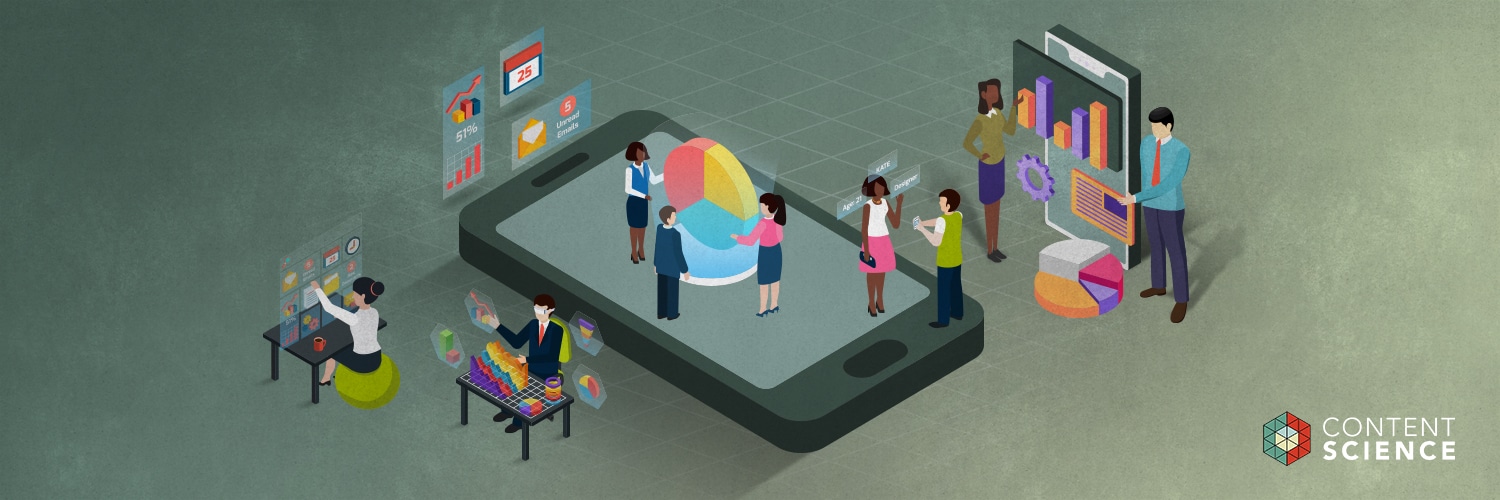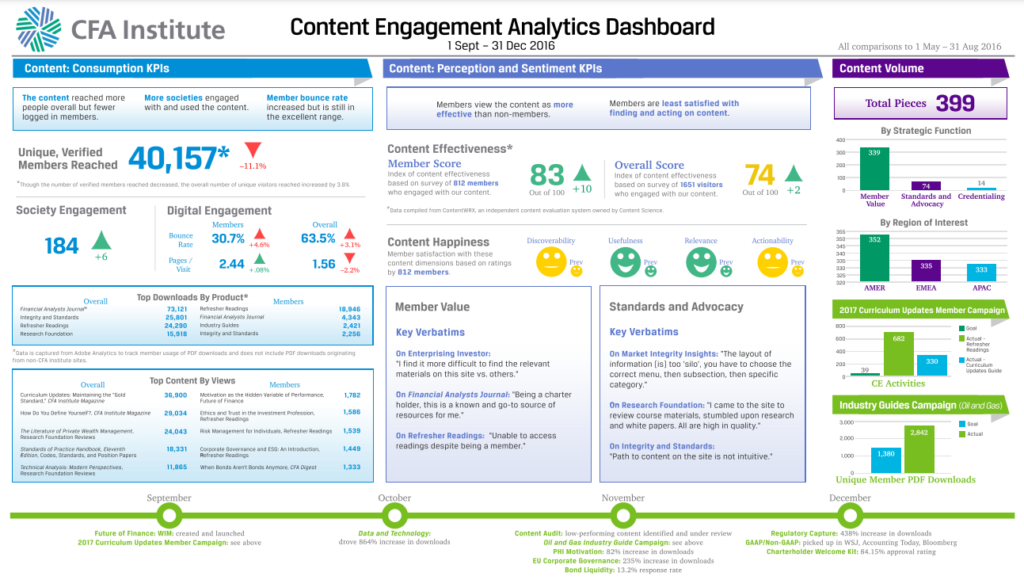
If you’re measuring content based on a plan, congratulations. That’s a big achievement. (If not, you can start planning with the help of this article.) But measuring content, alone, is not enough to make a difference to your content’s impact. If you don’t have an approach to turn your content measurement into actionable insights, you’re not making the most of all that wonderful data and feedback. This article offers three tips to help you maximize your measurement efforts. But, first, a little background on content intelligence, of which content measurement is a component.
A Recap of Content Intelligence
At Content Science, we view content measurement as an important part of a larger system. The system of measuring or collecting data about content, analyzing it, and then using it in decisions is what we call content intelligence. When you have this system going, you can
- Make smarter decisions about content faster.
- Show progress quicker to keep momentum for changes or innovation.
- Avoid slow, painful content analysis and auditing the next time you want to innovate or evolve, like change your tech stack or redesign the experience.
- Gain first-party data about your customers to compensate for losing third-party data due to privacy legislation.
- Lay the foundation for advanced content automation and experimentation.
- Lay the groundwork for predicting the impact of content or experience changes.
So, there’s a lot to gain from working to turn your content measurement into insight you can act on. Let’s turn to the tips.
1. Make Content Measurement Reports Useful + Usable
Take the time to set up a great dashboard or report template for your content measurement. If the report or dashboard is easy to access and pleasant to view, you and your team will be much more likely to use it. Use visualizations, information design, accessibility best practices, chunking and labeling, and similar techniques. A few such techniques are evident in this sample dashboard for a credentialing.

It’s more achievable than ever to make a content measurement dashboard or report appear attractive because many tools help build-in good accessibility and visual design. The trick is the report also has to be useful. And applying all the graphic design in the world to your report or dashboard, alone, does not make it useful. After years of developing such reports and dashboards, the Content Science team and I have identified several ways to make them more useful:
- Answer the question, “so what?” with techniques such as
-
-
- Including a top-line statement about what has changed or what is significant.
- Using icons and colors together to help convey changes such as increases and decreases.
-
- Use the power of comparison to help put measurements in context. Consider comparing appropriate measurements to any or all of the following:
-
- A previous time period
- Industry benchmark
- Content type benchmark
- Your own (internal) benchmark or target
- Provide contextual help such as brief explanations of terms, the formula, or the data sources so people can gain better understanding faster.
2. Share + Review Content Measurement Reports at a Regular Cadence
After putting in the effort to collect data about your content and report on it, the last thing you want is for the report to sit on a shelf, in an email box, or in a folder unaccessed. Our content operations research has found a strong correlation between organizations evaluating content effectiveness regularly and reporting success. As further confirmation, McKinsey research has found one characteristic that sets companies apart in our digital age is reviewing data more frequently. So, getting this right is important.
Don’t leave reviewing your content measurement dashboard or report to chance or, even worse, people’s spare time. The most outstanding team members and supportive stakeholders often also are the most in demand. They might also abide by mantras like “if you have more than three priorities, you have none.” In other words, your best audience does not have spare time. So, these are a few practical ways to tie your report or dashboard into priorities and process.
- Send an email or notification prompting review of the report or dashboard, ideally at least monthly.
- Make the current and past reports or your dashboard(s) available through your center of content excellence / content community of practice.
- Make discussing the insights part of a regular meeting with leadership and / or stakeholders, ideally at least quarterly.
- Provide a webinar about interpreting and using the report or dashboard and turn the recording into on-demand training.
Different organizations can work very differently today, from asynchronous to lots of meetings, from remote to completely on site. So adapt these tips to how your organization works.
3. Set Up a Content Decision Framework
A decision framework makes it easy to go from answering the question “So what?” in tip one to “Now what?” This is where insight becomes actionable.
To help you start, I’m sharing three types of content decisions to include in your framework.

These types of decisions can apply to a wide variety of content types and contexts, which is why I consider them essential. Let’s walk through each type briefly.
Confirm and Optimize
With this decision, you recognize that your content is performing well or as expected, and you turn attention to opportunities to optimize the content. As a simple example, we worked with a UK university to use some of their content in native advertising with premium publishers. Within a few days of launching, we checked the report and found the content was exceeding native advertising benchmarks. That allowed us to experiment with optimizing headlines and images to further improve results.

Fix a Problem
When it comes to content problems, the question is when, not if, especially at large and growing organizations. But content measurement can help you spot problems faster and diagnose them more precisely so your team can address them before they hinder (or entirely prevent) reaching your goals. When you discover content isn’t having the impact you expected, you can investigate further with methods like these:
- Follow-up analysis to gain context, get more granular breakdown, or find correlations that shed light on the cause.
- Discussing what other campaigns, communications, or activities were happening at the time.
- Manual or automated review of content quality / adherence to standards.
- Usability-style testing or interviews.
- Review customer feedback + sentiment in tools like ContentWRX.
- A / B or multivariate testing (also helpful for optimizing).
Address an Opportunity
This decision is about watching for opportunities and being ready to make the most of them, such as
- Attracting an audience you didn’t expect, in a good way.
- Topics becoming more popular than expected.
- Content playing more of a role in conversions or sales than expected.
- Content accelerating the sales process faster than expected.
- Content increasing adoption of self service for resolving support issues more than expected.
As a brief example, several years ago Mailchimp launched a newsletter for ecommerce businesses called What’s in Store as an experiment. Within a few months, the newsletter had garnered more than 1 million subscribers who were highly engaged. Mailchimp realized they had a hit on their hands, so to speak, and committed to developing more content in more channels for ecommerce businesses.
So, if you’re evaluating content performance or effectiveness, you’re doing the right thing. But don’t stop there. Follow these tips to start turning your content measurement into actionable insights. With this system of content intelligence, you and your team can make better content decisions, faster.
A decision framework makes it easy to go from answering the question “So what?” to “Now what?” This is where insight becomes actionable.
-
Events, Resources, + More
The Ultimate Guide to End-to-End Content
Discover why + how an end-to-end approach is critical in the age of AI with this comprehensive white paper.
The Content Advantage Book
The much-anticipated third edition of the highly rated book by Colleen Jones is available at book retailers worldwide. Learn more!
20 Signs of a Content Problem in a High-Stakes Initiative
Use this white paper to diagnose the problem so you can achieve the right solution faster.
Upskill with Content Science Academy
Training for modern content roles through on-demand certifications + courses or live workshops.







Comments
We invite you to share your perspective in a constructive way. To comment, please sign in or register. Our moderating team will review all comments and may edit them for clarity. Our team also may delete comments that are off-topic or disrespectful. All postings become the property of
Content Science Review.